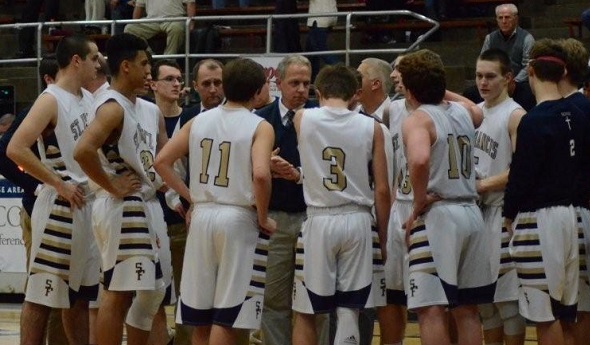
Cancer Free, Haske Pulls Double Duty
March 3, 2016
By Dennis Chase
Special for Second Half
TRAVERSE CITY – Keith Haske calls coaching basketball “therapeutic.”
 It’s a term that now holds more meaning for the 58-year-old Traverse City St. Francis basketball coach, who is recovering from a stage four throat cancer diagnosis two years ago.
It’s a term that now holds more meaning for the 58-year-old Traverse City St. Francis basketball coach, who is recovering from a stage four throat cancer diagnosis two years ago.
“When you’re coaching you just kind of lose yourself,” he said. “You don’t think about how you’re feeling or what you went through.”
Coaching has been a major part of Haske’s life for 32 years – 13 at St. Johns, 13 at Charlevoix and six at St. Francis. Even when he felt weak and tired last season, Haske continued as the boys coach, using an amplified headset at practice to lessen the strain on his throat.
His health, he said, is continually improving. He’s cancer free. His energy and strength are returning – so much so that he added to his workload this season by taking on the girls varsity coaching duties, too.
“When you go through this stuff you almost have a renewed energy,” he said. “Your body fights so hard to beat the cancer, and you go through so much suffering, that when you come out the other side things really don’t faze you as much.”
This is a time of the year that will test Haske’s stamina because his schedule is busier than ever. He coached three doubleheaders last week. With the girls reaching Friday’s MHSAA Class C District Final, he’ll coach five games in five days this week. It could be a repeat next week if the boys and girls advance along the tournament trail.
“I can’t tell you how much fun that would be,” Haske said.
Another tough District matchup awaits, though. The girls team (21-1) played Elk Rapids (15-6) on Wednesday and will next face host Glen Lake (20-2). The boys (12-7) will face Johannesburg-Lewiston (16-2) – the team that knocked the Gladiators out last season– in their District opener Monday.
It’s a challenging schedule. But Haske, who’s taken four teams to the MHSAA Finals, is accustomed to challenges. None bigger than his battle with cancer.
The diagnosis came the day after Easter in 2014. Haske, who kept physically fit, couldn’t believe what the doctor was telling him.
“I said, ‘There’s no way,’” he recalled. “I never smoked, never chewed tobacco, things you would attribute (to throat cancer).”
He wasn’t the only one stunned.
 “Most of the team started breaking down crying,” senior Dylan Sheehy-Guiseppi remembered when Haske broke the news. “We were so shocked. We couldn’t understand how it happened to him.”
“Most of the team started breaking down crying,” senior Dylan Sheehy-Guiseppi remembered when Haske broke the news. “We were so shocked. We couldn’t understand how it happened to him.”
Neither could Haske’s close friends.
“Your first take is that it’s pretty devastating because you don’t know (what to expect),” Adam Wood, who played for and coached under Haske at Charlevoix, said. “Cancer can run the gamut as far as severity. The one thing I did know is that he would fight it as hard as he could.”
Haske took his fight to the MD Anderson Cancer Center in Houston. He, and his wife Barb, spent most of the summer there as Haske underwent radiation and chemotherapy treatment.
It was on a return trip to Houston a few months later – he still goes back every four months for scans – when he learned he was cancer free.
“When I left (in July) they were still worried about one of the lymph nodes, whether they got it or not,” Haske said. “Sometimes it gets inflamed from the radiation, and they can’t tell.”
Turns out, it was inflammation. No cancer was detected.
On the way home, Haske received a call from principal Eric Chittle, who then revealed the good news at a school assembly.
“The whole student body went crazy,” Haske said. “It was cool.”
For Haske, the dean of students at the high school, it was a big hurdle to clear. But there was a side effect – Haske’s throat was still inflamed, and he struggled to eat.
“When I came back I went six months without eating a single morsel of food,” he said. “I lived on Ensure and ice cream.”
He ended up losing 53 pounds – and at one point inquired about a feeding tube.
“He (doctor) said, ‘You don’t need it. You’ve been through the worst. You’ll be all right,’” Haske recalled. “He was right. A couple weeks later it started to turn around.”
After the boys basketball season concluded last March, and as Haske’s health improved, the girls basketball job opened up. Haske had coached girls basketball at Charlevoix for three seasons, leading the Rayders to a 27-1 record and a Finals appearance in 2004. He stepped down when the girls season was switched from fall to winter.
St. Francis athletic director Tom Hardy thought about the possibilities and approached Haske, a member of the Basketball Coaches Association of Michigan Hall of Fame, about adding a second coaching job. After consulting with Barb, who he said has been “unbelievable” in his recovery process, Haske accepted.
Wood, who is now the boys basketball coach and athletic director at Lake Michigan Conference rival Harbor Springs, was among the first to call his former coach.
“He asked, ‘Adam, am I crazy?’” Wood said laughing. “My response was ‘Yes.’ He said, ‘I’ve been getting a lot of that lately.’
“For him to take that on was beyond impressive. It was all about the kids.”
What about physically?
“When I saw him this year I told him he looked great,” Wood said. “He said he felt great. The difference between this year and last is quite dramatic.”
Haske – who is mentoring two young coaches in the system, Tyler Sanborn and Stephanie DeNoyelles – said the casual fan might not even realize what he’s been through.
 “If you were looking at me across the gym you wouldn’t have any idea,” Haske said. “If you get closer, I still have some swelling in my jaw, and I talk a little funny sometimes.”
“If you were looking at me across the gym you wouldn’t have any idea,” Haske said. “If you get closer, I still have some swelling in my jaw, and I talk a little funny sometimes.”
But he’s enjoying every minute.
“The kids here are great, and that makes it so much easier,” he said. “You just don’t have many problems.”
The players are thankful to see their coach returning to his old self.
“He’s not only a basketball coach, he’s a mentor,” Sheehy-Guiseppi said. “He wants to make sure you’re taking care of stuff outside the game of basketball first. He really cares about you as a person, and he looks forward to helping you grow as a person.”
St. Francis officials adjusted Haske’s work schedule during the winter to accommodate his coaching, and Hardy had to work out arrangements with league members to schedule more varsity doubleheaders.
“All the schools were great about it,” Hardy said. “We have not had an issue with Keith having to be at two spots at the same time.”
Now comes the challenge of March Madness. And for the girls, that means a showdown with Glen Lake.
“They’re a lot like us,” Haske said, when asked about the Lakers. “They don’t have any one person you can key on. They have five or six girls that all share the ball and are dangerous. They’re tough in the paint and they can shoot. They’re very balanced, very sound.”
So are the Gladiators, who have won 19 in a row. Senior Annie Lyman is the leader, averaging 14 points, eight rebounds, five steals and five assists per game.
“She does it all,” Haske said. “She’s a tough, aggressive player.”
Juliana Phillips, a 6-foot-4 junior who has committed to play volleyball at St. Louis University, and 6-foot senior Lauren McDonnell also average in double figures.
Haske likes the growth he’s seen in his team.
“I think we’ve made great strides in understanding the system and what we’re trying to do,” he said. “We have some pretty talented kids. We have some size, some quickness, some kids who can shoot it. It’s a well-rounded team.”
The boys, meanwhile, are trying to find some consistency. Haske thought the Gladiators were turning the corner when Gabe Callery hit a mid-court shot at the buzzer to stun previously unbeaten East Jordan earlier this year. But St. Francis dropped three consecutive road games in February.
“A lot of it is shooting,” Haske said. “There are nights we just don’t shoot it well. When we do shoot it well, we’re a really good team.”
How good will be determined in March.
 Dennis Chase worked 32 years as a sportswriter at the Traverse City Record-Eagle, including as sports editor from 2000-14. He can be reached at [email protected] with story ideas for Manistee, Wexford, Missaukee, Roscommon, Ogemaw, Iosco, Alcona, Oscoda, Crawford, Kalkaska, Grand Traverse, Benzie, Leelanau, Antrim, Otsego, Montmorency, Alpena, Presque Isle, Cheboygan, Charlevoix and Emmet counties.
Dennis Chase worked 32 years as a sportswriter at the Traverse City Record-Eagle, including as sports editor from 2000-14. He can be reached at [email protected] with story ideas for Manistee, Wexford, Missaukee, Roscommon, Ogemaw, Iosco, Alcona, Oscoda, Crawford, Kalkaska, Grand Traverse, Benzie, Leelanau, Antrim, Otsego, Montmorency, Alpena, Presque Isle, Cheboygan, Charlevoix and Emmet counties.
PHOTOS: (Top) Traverse City St. Francis coach Keith Haske huddles with his boys basketball team during a game against Grayling. (Middle) St. Francis' girls team, here against Kalkaska, will play for a District title Friday. (Below) Haske speaks with a few of his players during a District game against Grand Traverse Academy. (Photos by Julie English.)

We Will Always Remember Trojans, Lumberjacks as 114-Year-Old Rivalry Nears End
By
Ron Pesch
MHSAA historian
February 9, 2024
The MHSAA basketball record book still lacks a rivalries category. The state’s football record book offers clues to likely candidates, but without deep research, the participants and sequencing of such lists will remain unknown.
Certainly, among the candidates would be the annual boys basketball battles between Saginaw’s east side and west side – Saginaw High vs. Saginaw Arthur Hill. Come Friday, Feb. 16th, 2024, twilight falls on one of Michigan’s most intense. Because of its significance, the game will be hosted outside of a high school gymnasium.
Saginaw’s Dow Event Center will stage the final regular-season showdown between the Trojans and Lumberjacks. Titled the ‘Game of Legends,’ all 5,000 tickets for the celebration were snapped up in 20 minutes. After years of discussions, at the end of the school year, Saginaw High and Arthur Hill will combine to finalize the formation of Saginaw United High School.
Based on the research of Dave Slaggert, the series between schools began during the 1910-11 season at the Saginaw Manual Training School gymnasium. Head varsity boys basketball coach at Arthur Hill from 1996 through 2001, Slaggert spent five years compiling a book documenting the rivalry. Much of the manuscript has already been committed to paper. That includes a chapter penned by Michigan State University coaching legend Tom Izzo, who highlights the uniqueness of the crosstown rivalry, the crazy fans, and the talent that brought him regularly to town. Titled “Remember the Trojans & the Lumberjacks,” the concluding chapter awaits the results of the 2024 season.
The Beginnings
In 1889, Michigan’s State Legislature consolidated the cities of East Saginaw and Saginaw City into what we know today as Saginaw.
East Side High School opened in 1865. In 1901, West Side High School was renamed Arthur Hill, in honor of a former school board president and mayor of Saginaw City.
Football teams from Saginaw High (sometimes called Saginaw Eastern) and Arthur Hill High first met on the gridiron in 1894. In 1904, both joined Flint (Central) and two schools from Bay City to form the Saginaw Valley League. During the 1910-11 season, the boys squads from the Saginaw schools squared off on the basketball court for the first time.
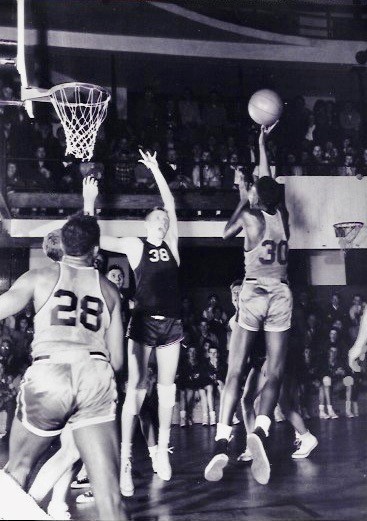 “Saginaw High easily defeated the Arthur Hill High school basketball players … in the first game of the interscholastic series,” stated the Saginaw Daily News, “the final score standing 60 to 17. … (Bill) Steckert contributed 12 field baskets for the winners. … (Leo) Vondette starred for the losers.”
“Saginaw High easily defeated the Arthur Hill High school basketball players … in the first game of the interscholastic series,” stated the Saginaw Daily News, “the final score standing 60 to 17. … (Bill) Steckert contributed 12 field baskets for the winners. … (Leo) Vondette starred for the losers.”
Perhaps it was a typo – it’s impossible to know – but the final score differed in the 1911 Saginaw yearbook – “The Aurora” – when published in the spring. “Before a large crowd of enthusiastic fans, Arthur Hill was decisively defeated in the local gym, the final count being 69 to 17, with the East Siders on the heavy end.”
The author concluded with flair and flourish: “Steckert starred for Saginaw, getting 24 points to his credit, while Vondette was the celestial light for the vanquished quintet. Dancing was enjoyed after the game.”
A week later, the Saginaw girls basketball team opened its season against the west siders. According to the yearbook, “Saginaw out-played Arthur Hill and defeated them by the score of 41-4.” The newspaper credited Leona Buck as the leading scorer, with a phenomenal 29 points.
The Inevitable Finale
The doors open at 3 p.m. for the 2024 festivities at The Dow next Friday. Fittingly, the Saginaw girls team will tip off the action on the court at 5 o’clock. The girls programs already have consolidated, and the Phoenix of Saginaw United will face Flint Carman-Ainsworth – a school that consolidated in 1986. The Hill and High contest is scheduled for 7 p.m.
“It’s really going to be a big deal,” said Slaggert, thrilled by the prospect. “Saginaw’s going all out for this. They’re trying to do it up in style.”
The wrap-up comes a decade after what, initially, looked like the end.
On Feb. 15, 2014, Detroit Free Press sportswriter Mick McCabe wrote about the expected unification.
“Saginaw and Saginaw Arthur Hill likely met for the last time ever in the regular season Friday,” he wrote. Saginaw had just knocked off the Lumberjacks, the No. 2 team in McCabe’s weekly ranking of the state’s top teams.
“The Saginaw-Arthur Hill basketball rivalry is the best in the state, so you shouldn’t be surprised when the underdog wins. But Saginaw (11-6) was coming off consecutive losses to Midland and Midland Dow for maybe the first time ever.”
The school district was expected to announce the closure of Saginaw High that following Monday, merging its students into Arthur Hill. The move would mean a new school name, new school colors, and a new nickname.
Like many urban centers across the country, outbound migration of both jobs and people, combined with plunging birth rates, had altered the demographics of cities, and the education landscape.
“In just five decades, the city's population dropped from nearly 100,000 in the 1960s to fewer than 52,000 by the 2010 census,” stated the Saginaw News in 2014. “To say it another way, Saginaw lost 48 percent of its residents during the last 50 years.”
McCabe cut to what that meant to enrollment numbers at the two schools: “In 1987, Saginaw High had over 1,800 students; it is now down to about 600. Arthur Hill had 2,395 students in ’85; it now has 973.”
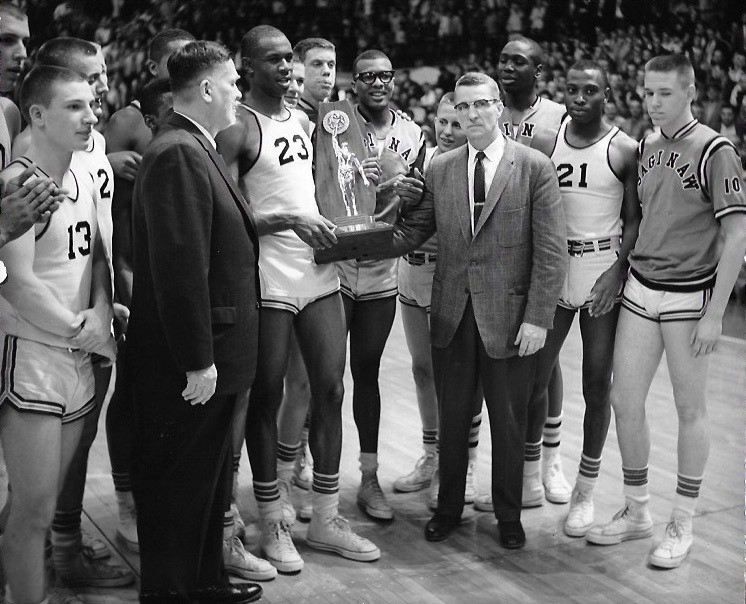 Despite the defeat, McCabe predicted Arthur Hill to be among the final four Class A teams still standing that season when the annual MHSAA Tournament shifted to Michigan State’s Breslin Center. But in the craziness of March, the Trojans again took down Arthur Hill in the Districts, 53-51.
Despite the defeat, McCabe predicted Arthur Hill to be among the final four Class A teams still standing that season when the annual MHSAA Tournament shifted to Michigan State’s Breslin Center. But in the craziness of March, the Trojans again took down Arthur Hill in the Districts, 53-51.
Adding to the madness, the expected consolidation didn’t happen. A recommendation by a Saginaw interim superintendent to close Saginaw High found no school board support.
With the potential consolidation still hovering, one year later sportswriter Bill Khan recalled other recent departures from Michigan’s classic basketball landscape in an article for the StateChamps! Sports Network:
“The Saginaw-Arthur Hill rivalry is at risk of going the way of other great urban rivalries – such as Flint Central-Flint Northern, Pontiac Central-Pontiac Northern, Lapeer East-Lapeer West, Detroit Cooley-Detroit Southwestern, Detroit Mackenzie-Detroit Redford, Detroit Kettering-Detroit Northeastern, Detroit Miller-Detroit Northern and Detroit Southeastern-Detroit Eastern, that have ended in years past due to school closures and consolidations.”
Arthur Hill downed the Trojans twice during the 2014-15 regular season league action, and again in postseason District play, before finishing the year as Class A runner-up, and the holding pattern of the planned school merger continued.
Enrollment numbers continued to drop at both schools and after much community and school board debate, construction on a brand-new five-story Saginaw United High School began in 2022.
A Celebration of Statistics
The state basketball tournament kicked off in 1917. Over 107 years, on only two occasions – in 1943 during World War II, and in 2020, due to COVID-19 – the tournament was not completed.
Slaggert breaks down the City of Saginaw School District’s incredible basketball history in a quick series of numbers.
“47-36-18-8,” said Slaggert, stressing a bullet point of a well-rehearsed pitch, breaking out the incredible success of the two schools come tournament time.
“During those 105 tournaments, 47 times, Saginaw High (starting in 1919) or Arthur Hill (beginning in 1930) made it into the state Quarterfinals – the final eight.
“That’s almost half of the 105 possible years. And in most cases throughout that rivalry, they would have played each other in the Districts. So how many more times would they have made it if they were coming in different brackets or different directions? “
To take that further, he noted, 36 times one of those teams made it into the final four. On 18 occasions, one of the two schools reached the state title game, and on eight occasions, they emerged as MHSAA state champions.
Six of those titles were won by Saginaw High (1942, 1962, 1996, 2007,2008, 2012). Arthur Hill’s championships were won in 1944 and 2006.
“That's a pretty incredible stat for two schools in the same town, don’t you think?” Slaggert asked.
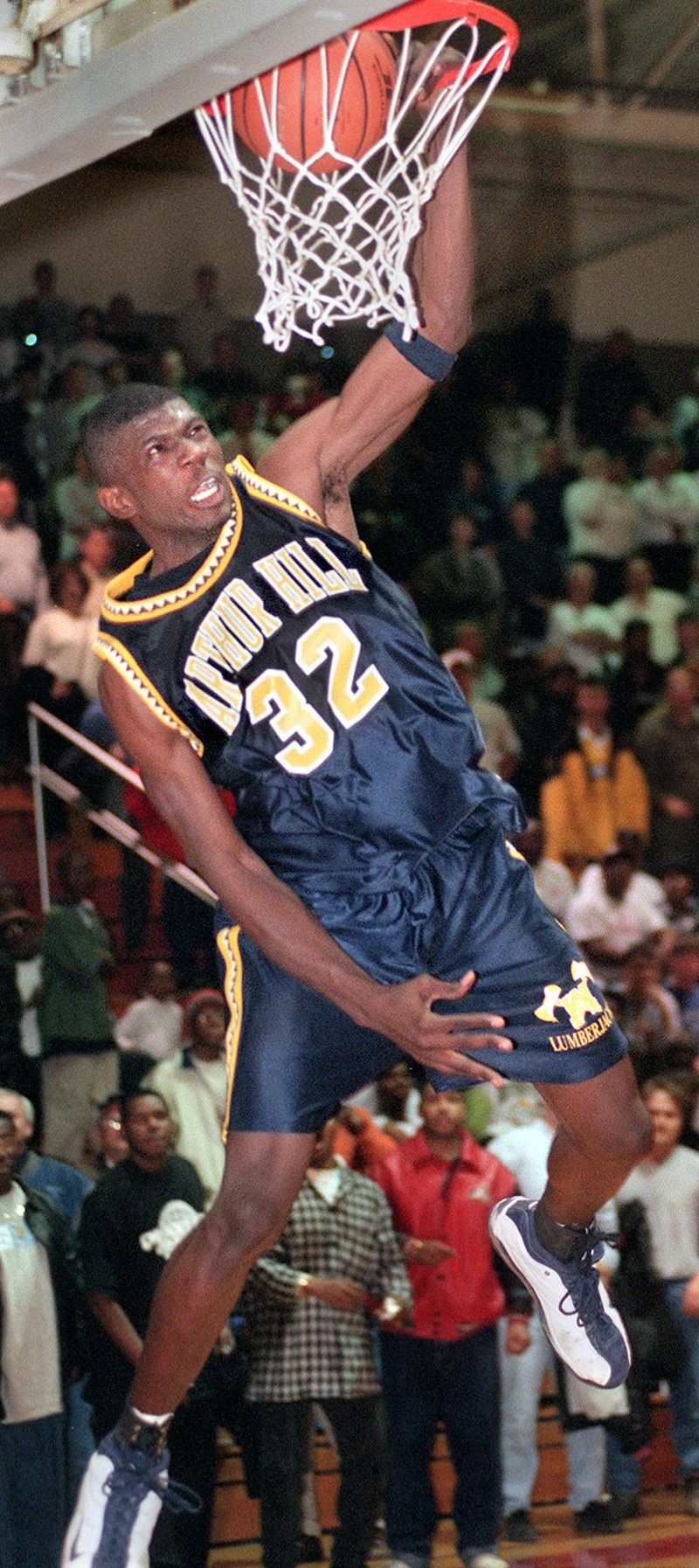 That history also points out another Slaggert challenge. As illustrated, come March the schools could, in theory, bump into each other one more time come the postseason. This year, the teams are in different Districts, and could potentially cross paths in an MHSAA Regional.
That history also points out another Slaggert challenge. As illustrated, come March the schools could, in theory, bump into each other one more time come the postseason. This year, the teams are in different Districts, and could potentially cross paths in an MHSAA Regional.
A Parade of All-Staters
Between 1938 and 2023, a combined total of 106 players from the two schools – 10 or more in each decade from the 1940s to the 2010s – have earned all-state basketball honors from The Associated Press and/or one or more of the Detroit newspapers: the Free Press, News or Times.
Since the introduction of Michigan’s Mr. Basketball award in 1981, honoring the best-of-the-best from the state’s top high school seniors, 10 players from the two schools have landed among the top five in voting: Eric Davis (AH –‘15), Maurice Jones (AH –‘10), Draymond Green (S –‘08), Dar Tucker (AH –‘07), Anthony Roberson (S –‘02), Eugene Seals (S –’00, and head coach of the United girls basketball team), Jason Richardson (AH-‘99), Jessie Drain (S –‘91) and Daryl Reed (S –‘87). Richardson won the award. Davis, Green, Tucker, Roberson, and Seals all finished second in the annual voting.
Tony Smith (S -‘74), Craig Dill (AH -‘63), Ernie Thompson (S -‘62), Webster Kirksey (S -‘51), Dick Rifenburg (AH -‘44), and Larry Savage (S -‘42) were all honored by the Basketball Coaches Association of Michigan with their Retro Mr. Basketball Award when the organization sought to honor the great seniors in Michigan high school basketball from the years 1920 through 1980. Seven others – James Koger (S -‘79), Lovell Humes (S – ’63), Bill Agre (AH -‘47), Gene Glick (AH -’46), Jack Mott (AH -’45), Eddie Johnson (S – ’43) and Stanley Paskiewicz (S -’38) – were among the candidates for that award.
Based on research by Orchard Lake St. Mary’s Robin Goddard, Saginaw High is likely the state’s winningest basketball program, trailed by Benton Harbor, Kalamazoo Central and Orchard Lake St. Mary’s.
Initially, Saginaw dominated the crosstown series with the Lumberjacks. But by the 1920s Arthur Hill overcame the deficit, and by the mid-1950s the Hill had opened a wide 25-game lead in wins versus losses. But by 1975, the gap had narrowed with the Trojans just six games back in the series. And yet, the exact status of the rivalry is still unknown, as the capture of game scores is spotty going forward.
The digging to capture those missing scores continues, as does the race to game day.
Slaggert has committed to printing 1,000 copies of his book. His challenge to date has been selling copies of something that does not yet, physically, exist. As it stands, currently there are 772 pages in the book. It includes a mind-blowing 800+ photos dating as far back as 1905. The sale price is fixed at $40. That currently means the production cost per copy exceeds the retail price, so Slaggert continues to chase sponsorships to defray the printing expense.
“It’s a non-profit effort,” he noted. “If there are any profits, they go to scholarships for the new high school. All money is run through the Saginaw Community Foundation,” which makes sponsorships tax-deductible.
His favorite memory from the series is his last victory as an Arthur Hill coach. It comes from 2001.
“Saginaw High defeated us 90-37 in the second game of that season and finished with a 17-5 season record that year,” he retold. “We had a modest 10-10 season record heading into the Districts but showed lots of improvement through the season. We met again in the District Finals. Saginaw High was led by Anthony Roberson, LaMarr Woodley, Michael Thomas and Tanoris Shepard and was ranked seventh in the state. In front of a sold-out Heritage High School crowd, our kids played their hearts out and, led by Devaundre Whitson, Omar Linder, and Freddy Jackson, pulled out a 68-66 overtime win! (It’s) my greatest thrill in coaching, and most of the old-timers say it’s the greatest upset in the rivalry.”
Slaggert retired from coaching after that season, and in the years to follow, found a desire to record the history of the series.
“I have nine living coaches from Saginaw and Arthur Hill that have written a chapter for me. I have eight others that I've written on Larry Laeding, Chuck Fowler, and different coaches that are deceased,” he said. “My intent is to give something back to my community. I didn’t do this for money. I wanted this story to be passed down to future generations – people 100 years from now about Jason Richardson, Draymond Green, Ernie Thompson, Craig Dill, and all the great ones.
“It’s a labor of love for me, I’ve really enjoyed it.”
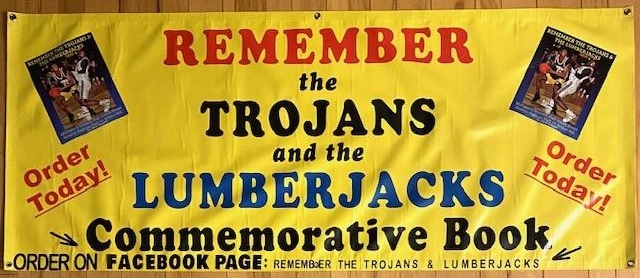 To order Slaggert's book, click for the Facebook link or visit the Saginaw Community Foundation website, click "Give Now" and select the book title as Fund. Cost is $40 with an option including shipping for $52.
To order Slaggert's book, click for the Facebook link or visit the Saginaw Community Foundation website, click "Give Now" and select the book title as Fund. Cost is $40 with an option including shipping for $52.
PHOTOS (Top) Saginaw Eugene Seals drives against Arthur Hill’s Jason Richardson – with coach Marshall Thomas in the background – during a sold-out 1999 game at the Saginaw Civic Center. (2) Arthur Hill’s Ernie Thompson and coach Larry Laeding accept the 1962 Class A championship trophy. (3) Saginaw High’s Webster Kirksey (30) puts up a shot; he graduated in 1951. (4) Richard dunks at the final buzzer as Arthur Hill downs top-ranked Flint Northwestern in a 1999 Class A Regional matchup. (Photos collected by Dave Slaggert. Top photo courtesy of Saginaw News/MLive.)

